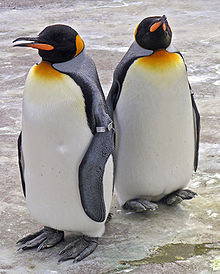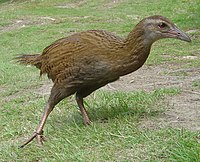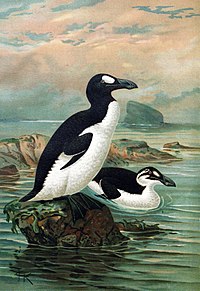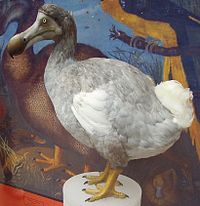Flightless bird

Flightless birds are birds that lack the ability to fly. These species rely on running and/or swimming instead of flying, but they did evolve from flying ancestors.[1] There are about 40 species in existence today,[2] the best known being the ratites (ostrich, emu, cassowary, rhea and kiwi) and the penguins. Some birds evolved flightlessness in response to the release from predation, for example on oceanic islands, although this is likely not the case for the ratites as evolutionary origins suggest a continental biogeographical providence. [citation needed]
Two key differences between flying and flightless birds are the smaller wing bones of flightless birds[3] and the absent (or greatly reduced) keel on their breastbone. (The keel anchors muscles needed for wing movement.[2]) Flightless birds also have more feathers than flying birds.
New Zealand has more species of flightless birds (including the kiwis, several species of penguins, and the takahe) than any other country. One reason is that until the arrival of humans roughly a thousand years ago, there were no large land predators in New Zealand; the main predators of flightless birds were larger birds.[4]
Some flightless varieties of island birds are closely related to flying varieties, implying flight is a significant biological cost.[citation needed]
The smallest flightless bird is the Inaccessible Island Rail (length 12.5 cm, weight 34.7 g). The largest (both heaviest and tallest) flightless bird, which is also the largest living bird, is the ostrich (2.7 m, 156 kg), although some extinct species grew to larger sizes.
Flightless birds are the easiest to take care of in captivity because they do not have to be caged. Ostriches were once farmed for their decorative feathers. Today they are raised for meat and for their skins, which are used to make leather.
There were also other families of flightless birds, such as the now extinct Phorusrhacidae, that evolved to be powerful terrestrial predators.
Many domesticated birds, such as some breeds of domestic chicken and domestic duck, have lost the ability to fly, though their wild ancestors, the red junglefowl and mallard, respectively, are perfectly capable of flight.
List of recent flightless birds
The following are flightless birds from the Holocene epoch. Extinct species are indicated with a dagger (†).
Ratites

Anseriformes (Waterfowl)

- Moa-nalos †
- Bermuda Island Flightless Duck †
- Fuegian Steamer Duck
- Falkland Steamer Duck
- Chubut Steamer Duck
- Auckland Teal
- Campbell Teal
- Dromornis †
- Genyornis †
- Chendytes lawi †
- Kaua'i Mole Duck †
- New Zealand geese †
Galliformes (Wildfowl)
Podicipediformes (Grebes)
- Junin Grebe
- Titicaca Grebe
- Atitlán Grebe † (reportedly flightless)[5]
Pelecaniformes (Pelicans, Cormorants and allies)

Sphenisciformes (Penguins)
Coraciiformes (Kingfishers, Hornbills and allies)
Ciconiiformes (Herons, Ibis)
Gruiformes (Cranes, Rails)


- Cuban Flightless Crane †
- Red Rail †
- Rodrigues Rail †
- Woodford's Rail (most likely flightless)
- Bar-winged Rail † (probably flightless)
- Weka
- New Caledonian Rail
- Lord Howe Woodhen
- Calayan Rail
- New Britain Rail
- Okinawa Rail
- Guam Rail
- Roviana Rail (flightless, or almost (so)[6]
- Tahiti Rail †
- Dieffenbach's Rail †
- Chatham Rail †
- Wake Island Rail †
- Snoring Rail
- Inaccessible Island Rail
- Laysan Rail †
- Hawaiian Rail †
- Kosrae Crake †
- Ascension Crake †
- Red-eyed Crake
- Invisible Rail
- New Guinea Flightless Rail
- Lord Howe Swamphen † (probably flightless)
- North Island Takahe †
- Takahe
- Samoan Wood Rail
- Makira Wood Rail
- Tristan Moorhen †
- Gough Island Moorhen
- Tasmanian Nativehen
- Giant Coot (adults only; immatures can fly)
- Adzebills †
Charadriiformes (Gulls, Terns, Auks)
Falconiformes (Birds of prey)

Psittaciformes (Parrots)
Columbiformes (Pigeons, Doves)
Caprimulgiformes (Nightjars)
Strigformes (Owls)
- Cuban Giant Owl †
- Cretan Owl † (probably flightless)
- Andros Island Barn Owl †
Passeriformes (Perching Birds)
See also
- Feathered dinosaurs
- Origin of birds: Secondary flightlessness in dinosaurs
- List of extinct birds
- Gastornis
- Phorusrhacidae
- Ratite
- list of endangered animals
References
- ^ "New Zealand Ecology – Moa". TerraNature. Retrieved 2007-08-27.
- ^ a b "The Bird Site: Flightless Birds". Archived from the original on 2007-07-13. Retrieved 2007-08-27.
- ^ Nudds, R. L. and Slove Davidson, J. (2010). "A shortening of the manus precedes the attenuation of other wing-bone elements in the evolution of flightlessness in birds". Acta Zoologica. 91: 115. doi:10.1111/j.1463-6395.2009.00391.x.
{{cite journal}}: CS1 maint: multiple names: authors list (link) - ^ "New Zealand's Icon:Flightless". Archived from the original on 2007-08-18. Retrieved 2007-08-27.
- ^ Hunter, Laurie A (1988). "Status of the Endemic Atitlan Grebe of Guatemala: Is it Extinct?" (pdf). Condor. 90 (4): pp. 906–912. doi:10.2307/1368847. JSTOR 1368847. Retrieved 2007-04-03.
{{cite journal}}:|pages=has extra text (help) - ^ Taylor, Barry (1998). Rails: A Guide to the Rails, Crakes, Gallinules and Coots of the World. Yale University Press. ISBN 0-300-07758-0.
External links
- TerraNature pages on New Zealand flightless birds
- Kiwi in Te Ara – the Encyclopedia of New Zealand
- The Flightless Birds Band
- Flightless birds in New Zealand
- Flightless Birds
